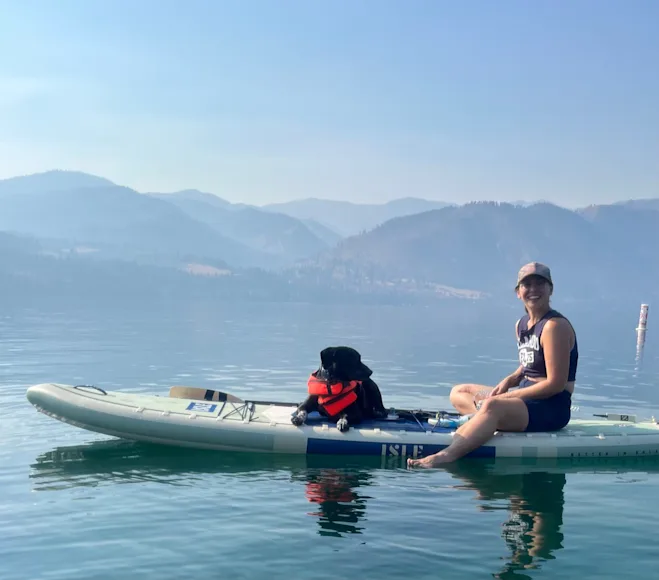_We may earn revenue from the products available on this page and participate in affiliate programs. Learn more ›
_
Runner Up
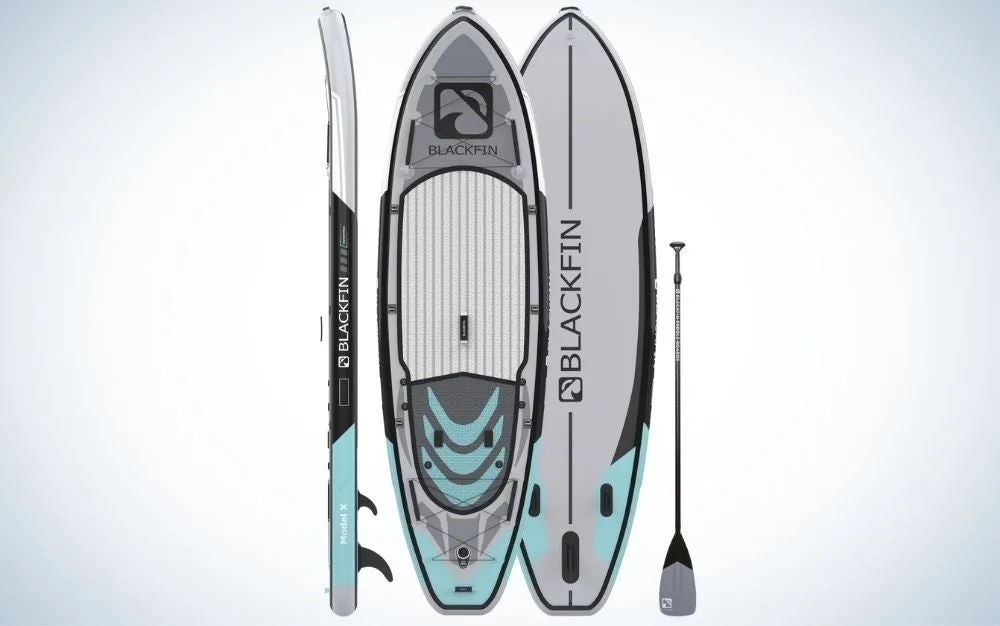
iRocker Blackfin Model X
Best for Beginners
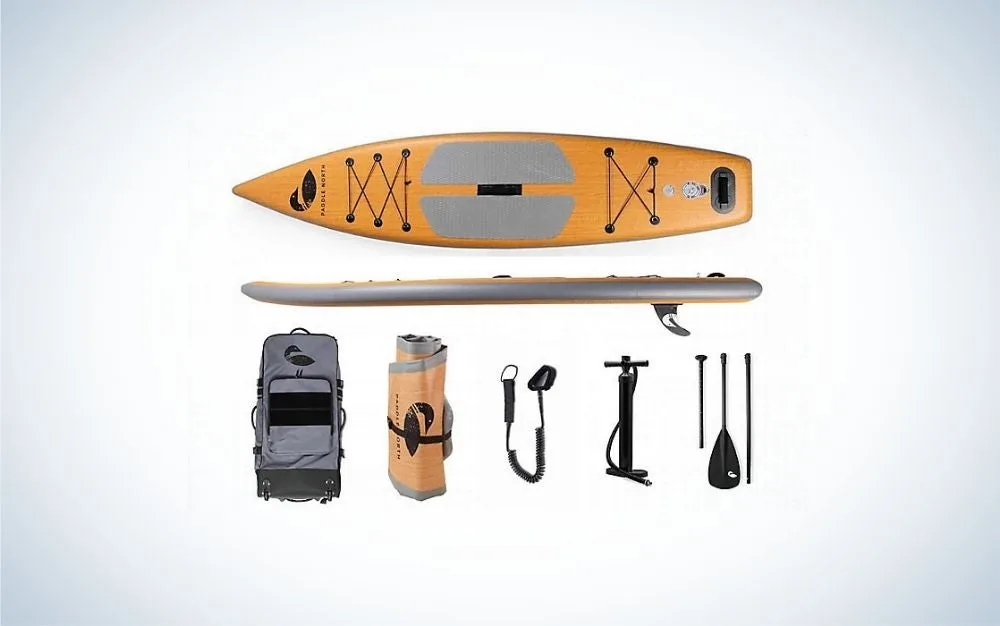
Paddle North Portager
Best Overall
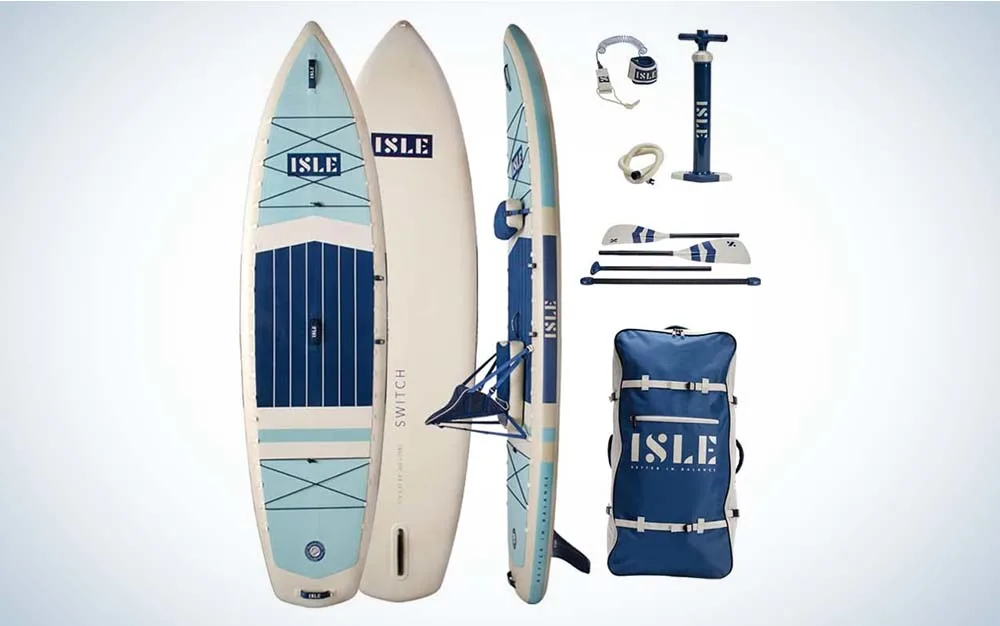
Isle Switch
There’s nothing like a day out on the water. The best inflatable paddle board can help you not only enjoy a peaceful day on the water, but they help you save space, are easier to transport, and often are less expensive than a classic SUP setup.
Inflatable SUPs will often be a cheaper option than non-inflatable ones. But much like other outdoor gear, the better the quality of the board, the more expensive it tends to be. While we took the price into account, we primarily focused on the quality of the board along with stand-out features and overall ease of use.
Best Overall: Isle Switch
Runner Up: iRocker Blackfin Model X
Best for Beginners: Paddle North Portager
Best High Weight Capacity: Pau Hana Oahu Nui Giant SUP
Best Lightweight: Honu Byron
Best Budget: iRocker Nautical
How We Chose The Best Inflatable Paddle Boards
While I’ve spent a fair amount of time on solid boards, most of my SUP experience has been on inflatable models. They’re easy to transport, you can rent them in many cities, and they’re great to lend out to friends. There are many great things about inflatable boards, but there is a lot of mixed messaging and an unfortunate number of low-quality options advertised.
Outdoor gear is an investment, and I want to make sure you get the most for your money. So, beyond the buying considerations we discussed earlier, I also took a few other things into account when choosing our top picks:
Materials: What materials are used throughout the board and other pieces? Do these materials allow for durable construction? What is the afterlife of these materials?
Longevity: How long do I plan to have this board? How long will this board last with how frequently I plan to use it? Is the board repairable? Is there a warranty?
Versatility: What types of paddling can I use the board for? Is the board usable for beginners? Can I loan the board out to friends? Is it stable enough for two people or a person and a dog?
Sustainability: Is the company transparent about its sustainability practices? Is this board able to be repurposed or recycled after use?
We also considered the company’s values and overall customer service if issues ever arise. Looking at verified customer reviews is always a must when shopping online, so never forget to browse a few of the most recent reviews to see if there are any glaring problems with quality.
The Best Inflatable Paddle Boards: Reviews & Recommendations
Best Overall: Isle Switch
Best Overall

Why It Made The Cut: The Isle Switch paddle board is a versatile, sturdy board that can easily be adapted to a variety of activities.
Key Features
Weight: 19 lbs
Inflated Dimensions: 11.6″ x 35.5″ x 6″
Fin Configuration: single
Best Use: flat water, fishing, yoga, recreational paddling
Pros
Lightweight and easy to transport alone
Straightforward setup
Stable on the water
Durable materials
Versatile 2-in-1 SUP/Kayak design
Cons
Inflating it is time-consuming (15-20 minutes) with the hand pump
If you’re looking for a relatively affordable inflatable paddle board that can be used for various activities and on more than just flat water, then the ISLE Switch is our top pick. Its straightforward setup makes it easy to pull it out of the box and get on the water in under 30 minutes. With the hand pump provided, when you’re inflating the board alone, it is relatively time-consuming (and tiring). It took about 20 minutes to inflate, but it could be faster if you don’t take breaks as I did!
With inflating, adding the fin, and putting the paddle together, the entire setup is easy to understand, even if you’re not the type to read instructions very thoroughly. Carrying everything to the water is also relatively easy alone since, when inflated, the whole setup weighs around 19 lbs. The handle makes that process even easier, especially if you have more than one person.
Once on the water, this board is amazing. It tracks well and is easy to maneuver. I tested the board alone, paddling with two people, and then again with me and one of my dogs. In all scenarios, this board was stable. Even with a dog walking around on board or two people moving from standing to kneeling to sitting, I never felt at risk of flipping over.
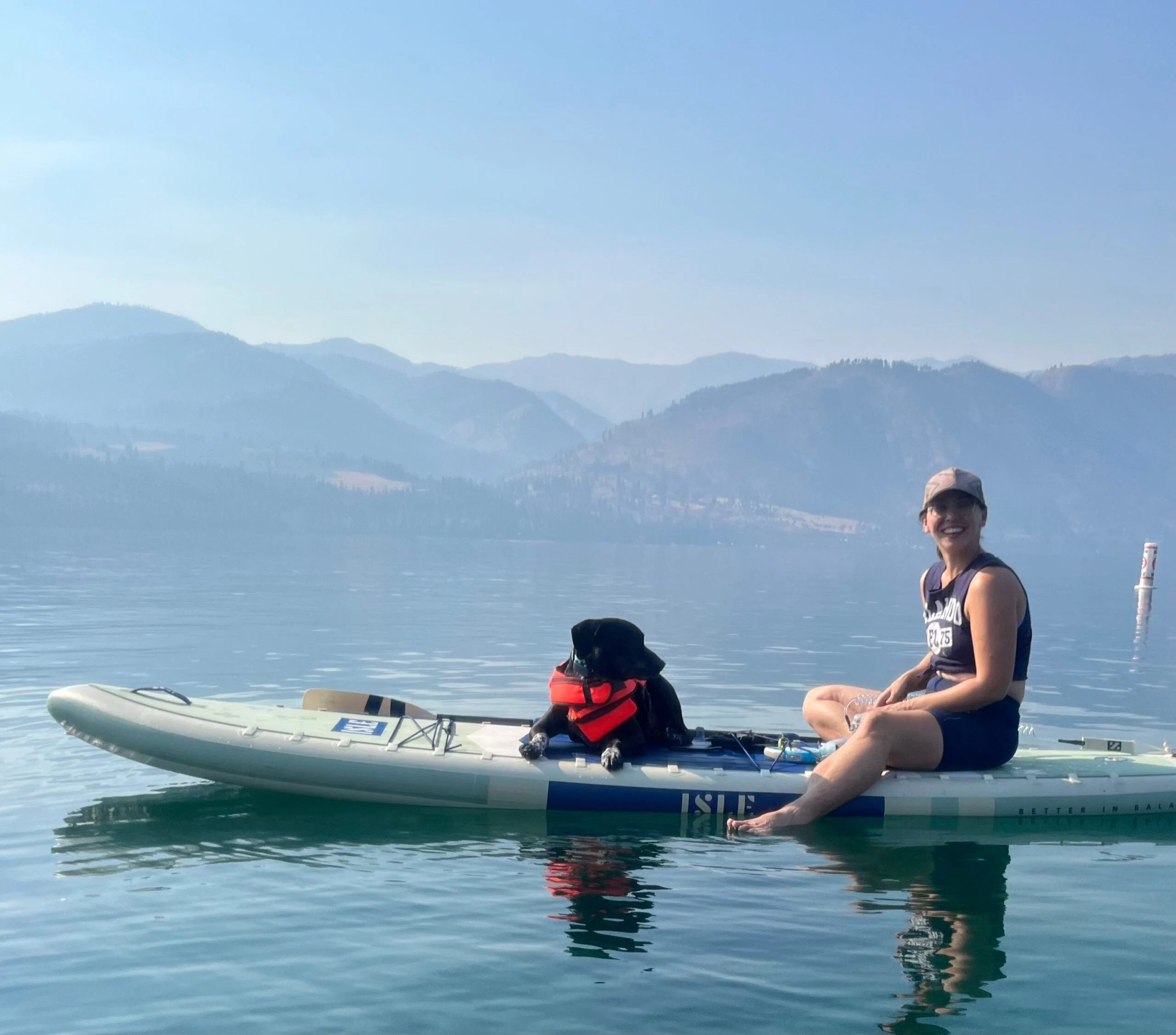
Day 3 of product testing (Lake Chelan, WA) – Meg Carney
Along with how wonderful it is on the water, it is equipped with some excellent features and one of the most comfortable padded decks. The top was grippy and soft while still durable enough to allow a dog on board without damaging it. There are several attachment points for gear, along with a handy paddle holder. The paddle holder is one of my favorite features, as it allows you to sit and relax on the water without the risk of dropping the paddle. It is great for sitting and having a snack on a day trip, fishing, or doing yoga. There are also attachments for a seat, so if you are fishing or using this more like a kayak, it provides a far more comfortable ride. No matter your positioning, it was easy to paddle and maneuver. We recommend choosing if you will be sitting or standing more on the water so you can set up your paddle accordingly.
Runner Up: iRocker Blackfin Model X
Best For Fishing

iRocker Blackfin Model X Irockersup
Why It Made the Cut: The iRocker Blackfin Model X is a high-performing and versatile board that suites paddlers from beginner to advanced.
Key Features
Weight: 27 pounds
Inflated Dimensions: 10’6” L x 35” W
Fin Configuration: 2+1
Best Use: Flat water, fishing, ocean, white water
Pros
Fishing mounts
Great stability
Easy to inflate (option for an electric pump)
Varying applications
Cons
No paddle holder on board which could be tricky when fishing
The iRocker inflatable paddle boards are among the best inflatable paddle board, and their Blackfin Model X stands out to us as the best overall for our list. It is a durable, versatile, and easy-to-use board that paddlers of all experience levels can enjoy. This is a great board if you are a beginner because it can continue going as you improve your paddling skills. If you’re already an advanced paddler, you’ll enjoy the functionality and portability of a high-quality inflatable SUP.
Along with the impressive amount (seven) of action mounts, there is also a large rear cargo area, making this a great fishing or touring board. The main downside to this board is that there is no paddle holder, which would be nice for activities like fishing. They designed the Blackfin Model X to have a triple-layer composite PVC construction and a drop-stitch inner core, making it a durable board. With that and the carbon fiber rails, this is one of the stiffest inflatable paddle boards available.
It has a 450-pound weight limit and seems to function well at capacity. The more weight you put on the board, the slower and harder it will become to paddle, so always note the weight of your gear combined with the rider’s weight before heading out.
Best for Beginners: Paddle North Portager
Best for Beginners

Paddle North Portager Moosejaw
Why It Made the Cut: The Paddle North Portager inflatable paddle board is made for everyone, but beginners will especially appreciate the design as they hone their skills.
Key Features
Weight: 21 pounds
Inflated Dimensions: 11’6” L x 33′ W’
Fin Configuration: Single
Best Use: Flat water, yoga, fishing, rivers
Pros
Versatile applications
Extremely durable
Universal valve for easy inflation
Four-year manufacturer warranty
Cons
Can be tiring to inflate by hand
Paddle North has a wide range of watercrafts available, and their Portager inflatable board is one of the best inflatable paddle boards a beginner could ask for when investing in a SUP. They are incredibly durable (check out their durability test, it’s impressive), easy to maneuver, and stable enough for two paddlers or a paddler and a couple of dogs.
The Portager was born in the land of 10,000 lakes and its versatility for open flat water, rivers, and camping shows. It is a buoyant craft with a weight capacity of around 350 pounds. They also make a Portager XL that can hold up to 650 pounds, which is great for tandem paddlers. The 11’6” length of the board provides a straight tracking experience, and overall, it is very easy to maneuver and paddle. There is a large deck pad on the top of the board for grip while standing and two cargo locations.
The built-in pressure regulator helps you inflate the board to your preferred stiffness and prevents overinflation. Since it has a universal valve for inflation, you can either use their provided hand pump or most electric pumps to make the experience easier.
Best High Weight Capacity: Pau Hana Oahu Nui Giant SUP
Best High Weight Capacity
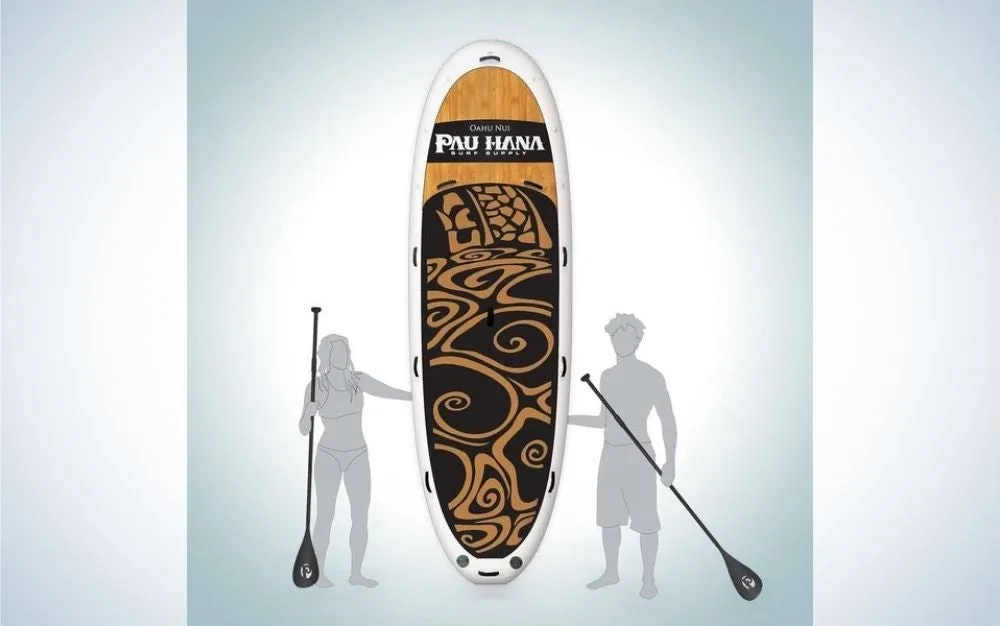
Pau Hana Oahu Nui Giant SUP Pau Hana Surf
Why It Made the Cut: The Pau Hana Oahu Nui Giant SUP is one that the whole family can hop on at once. It is roomy, stable, and has the highest weight capacity you’ll find.
Key Features:
Weight: 59 pounds
Inflated Dimensions: 15’ L x 54” W
Fin Configuration: 2+1
Best Use: Group paddling, yoga, fishing
Pros
Dual inflation valves
Extremely stable
Comfortable to sit or stand on while paddling
Several areas for storage onboard
Cons:
Large size and heavy weight doesn’t fit all paddling scenarios
The Pau Hana Oahu Nui Giant isn’t the only option for a high weight capacity board by this company, but it is likely the highest you’ll find on the market with a capacity of 1,000 pounds. These boards allow you to take the whole gang, dogs and all, out on the water. Whether you’re out for an adventure paddle or you want to have a leisurely lounge on the water with some snacks, this board is a great option.
It is a lot to carry with such a large size, so being almost 60 pounds, you may want to have a few friends help you bring it to the water. The good news is that it has several handles to allow for a group carry, and there are two valves for inflation to let two people pump simultaneously. Several D-rings and bungee cords on deck provide a secure space for everyone’s gear aboard, and it even comes with two paddles.
The planing hull provides for an easy to maneuver board and one that is epically stable even with movement aboard. Sitting down on the board is just as comfortable as standing with the large EVA foam deck pad across most of the top of the board. Although I love the idea of this board for tandem paddling or group ventures, it doesn’t necessarily have the best application for all forms of paddling. It can work well for folks that need a high weight capacity, but the board’s width can make it hard to paddle alone.
Best Lightweight: Honu Byron
Best Lightweight
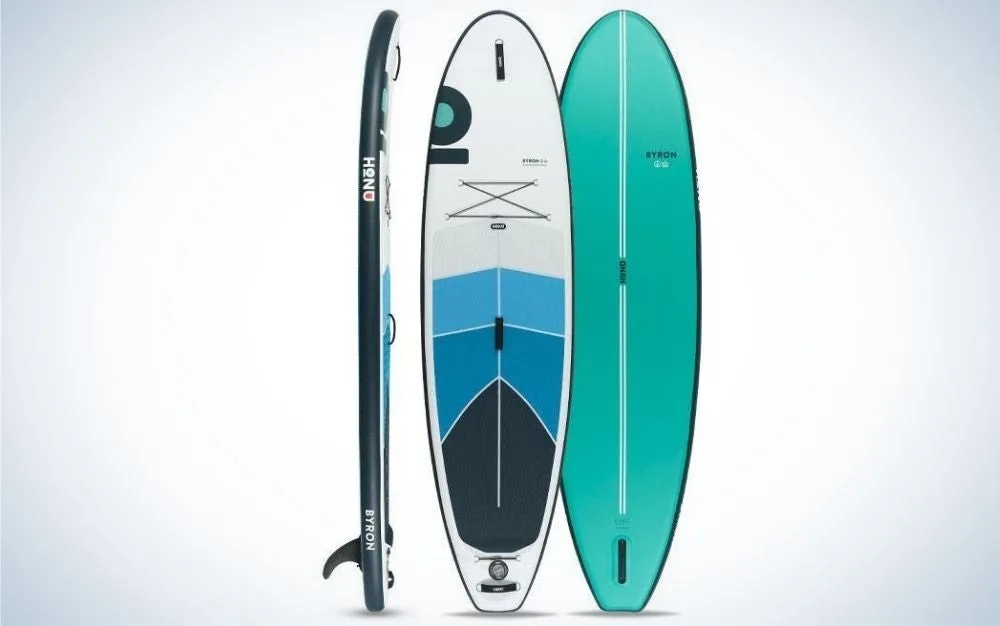
Honu Byron Honu Boards
Why It Made the Cut: You’ll be hard-pressed to find a lighter inflatable SUP that performs as well as the Honu Byron board. It is an all-around versatile board and easy to haul around alone at just 17 pounds.
Key Features
Weight: 16.9 pounds
Inflated Dimensions: 10’6” L x 32” W
Fin Configuration: Single
Best Use: Flat water, surfing, yoga, rivers
Pros
Light and portable
Very responsive while paddling
Ideal for improving paddling abilities
Four-year warranty
Cons
Thinner than most boards making it less stable
The Honu Byron is my top pick for the lightest weight inflatable paddle board, providing an easy-to-transport and handle SUP. It is just under 17 pounds, with excellent responsiveness in various water types.
Although it is a lightweight board, it is still quite durable. Honu boards utilize an X-woven drop-stitch, which allows them to produce such high-quality lightweight models. The PVC nylon threads weave together like carbon fiber as opposed to the standard knitted pattern. This technique provides a lighter and stiffer inflatable board.
Since the board is thinner than many other options, it does have its downsides and may take beginner paddlers some time to adjust. It is a very responsive board, but that means you will be less stable overall. All in all, if you are looking for a versatile option that is lightweight and easy to travel with, you should consider the Honu Byron.
Best Budget: iRocker Nautical
Best Budget
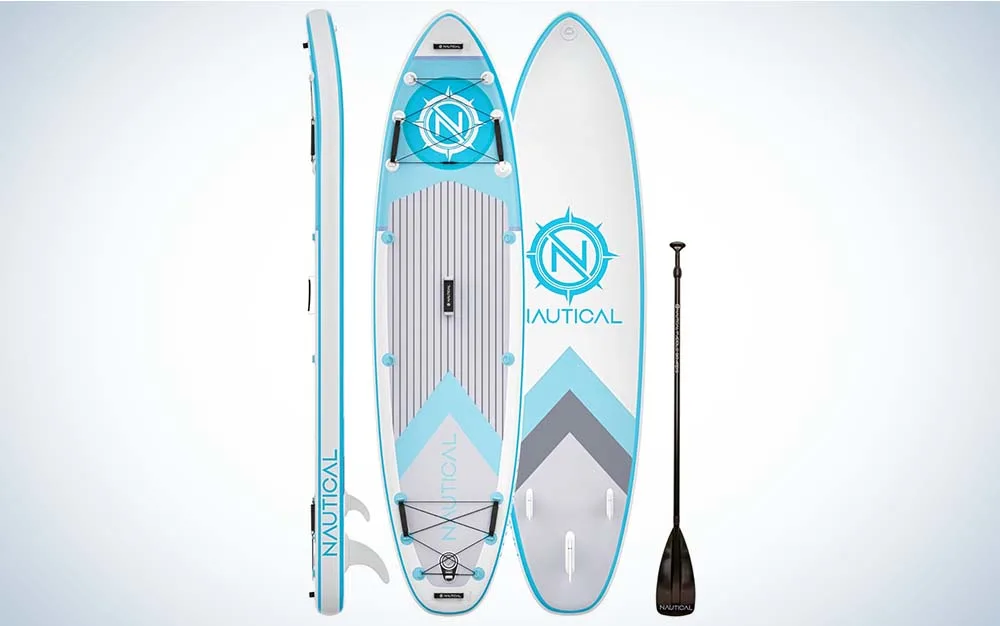
iRocker Nautical
Why It Made the Cut: Not all beginners have the budget for the best of the best, but the iRocker Nautical makes SUPing more affordable and accessible.
Key Features
Weight: 20 pounds
Inflated Dimensions: 10’6” L x 32” W
Fin Configuration: 3-fin thruster setup
Best Use: All-around entry-level
Pros
Versatile
Maneuverable and stable
Lightweight and portable
Ideal entry-level board
Cons
Not as high performing as more expensive iRocker boards
Another iRocker board that made our list, the iRocker Nautical is the best inflatable paddle board for entry-level paddlers looking for a more affordable option. While it may not perform at as high of a level as other iRocker options, for the price, you are getting excellent quality, and the overall value is there.
If you are getting into paddling, this board gives you the versatility to try out several different types of paddling, from accessible flat water lakes and ponds to faster-moving rivers. It provides enough stability to fish or tour as well. There are plenty of D-rings and bungee cords on deck for all gear storage and an awesome deck pad to improve your ability to move around on top of the board.
The low price does not seem to compromise much in terms of durability either. It is made with dual-layer military-grade PVC composite protection and a classically sturdy build. The accessories come in an easy-to-carry bag. If the size doesn’t quite suit you on this version of the iRocker Nautical, they make an 11’6” version that is a bit more expensive but adds better stability and speed while paddling.
Things to Consider Before Buying The Best Inflatable Paddle Boards
Before checking out my top picks for the best inflatable paddle board, read about the things to consider before buying. While it is nice to have a few awesome SUP choices, as we have listed, it’s necessary to identify your personal buying needs and preferences. Several factors can influence your buying decisions. So, to help you navigate all of your options and understand SUP specs, I recommend looking at the following criteria before investing in your very own SUP.
Type of Board
Before deciding whether an inflatable board is suitable for you or not, it is important to consider the pros and cons of both solid and inflatable boards.
Solid SUPs: Built from various materials, each one performing slightly differently, solid boards perform at a higher level than most inflatable options. Solid boards tend to be more customizable, allowing you to cater the board design more closely to the type of paddling you prefer and your body type. They are more rigid and ride lower in the water than inflatable boards, providing a more stable experience. The main downside to solid boards is that they take up more room, requiring more storage and making them harder to transport.
Inflatable SUPs: If you are limited on space, are traveling, or have to hike to a paddling destination, inflatable boards are an excellent choice. They are very easy to store and transport. While solid boards provide more stability, inflatable boards have a softer feel, making them better suited for SUP yoga
by providing more comfort when doing different poses. Inflatable boards also seem to work better for whitewater as they can be easy to maneuver and have a better capability of bouncing off rocks and logs in the water.
Types of Hulls
In addition to the solid or inflatable construction, other aspects set boards apart, like the hull shape. There are two primary types of hulls that most SUPs will have, but some boards will be a hybrid of the two.
Planing Hull: Like a surfboard, planing hulls are flat and wide. These boards are easy to maneuver and ride well on top of the water to provide a very leisurely experience. Inflatable boards with planing hulls work well for activities like SUP yoga, casual paddling, surfing, and whitewater.
Displacement Hull: A SUP with a displacement hull comes to a point at the bow (front), much like a kayak
or canoe. The pointed design is meant to slice through the water to create a fast, smooth ride and improve overall efficiency as you paddle. While these can help cover long distances faster, they are less maneuverable than a planing hull and best suited for racing, touring, camping, or fitness paddling.
One hull type isn’t necessarily better than the other for a beginner paddler, but they both have their applications and can make certain types of padding easier.
Size of Board
The length, width, and thickness of the board will play into the handling and stability when in the water. First, let’s discuss how different board lengths influence handling. In general, longer boards are faster, and shorter boards are easier to maneuver.
Average SUP Lengths
Short (under 10’): Short boards are a great option for those looking to surf or if you need a SUP for kids. For children, a length of around eight feet is ideal. Most short SUPs have a planing hull, making them more maneuverable.
Medium (10-12’): A medium-sized SUP is a standard pick for most casual paddlers because it has the best general application. Boards of medium length also work well for SUP yoga. Most medium SUPs are designed with a planing hull, but you can find some with a displacement hull.
Long (12’ 6” and above): Most long SUPs have a displacement hull, making them fast. These are a great option for long distances or touring.
How long a board is will also impact the board’s weight and how big it is. So, factor in how far you may have to carry it and where you will store the board.
The width of the board also changes handling capabilities. The wider the board, the more stable it will be and the slower it will go. Most SUPs range from 25-36” and should be chosen according to ability level, body type, and type of paddling.
If you’ve paddled a lot and feel relatively experienced, a slimmer board can work well and allow for more speed. On the other hand, if you are new to paddling, a wider board can help you feel more secure on the water and improve your balance. If you plan on fishing from your SUP, a wider board is a better option, giving you more stability to cast and fight fish.
The smaller you are as a person, the slimmer the board you might want. If a paddle board is too wide for your body, it will be difficult to paddle, and if a board is too slim for your body type, the easier it will be to tip. Knowing your general reach with a paddle can help you narrow down the proper width to ensure you’ll be comfortable as you paddle and you won’t struggle to reach each side of the board.
Narrower boards are more efficient and can sometimes track straighter, making them ideal for touring or racing. Some campers or tourers prefer a wider board because they carry more weight with their gear, so a wide board provides a better surface and a more stable surface.
The final sizing aspect of the board to consider is the thickness. Even boards of the same length and width can have different thicknesses, and that one difference can impact the weight capacity and volume of the board. In general, the thicker the board, the higher its volume and the more weight it can support.
Weight Capacity and Volume
To have a better idea of how a paddle board will work for you, look at the weight capacity and volume of the board. You need a board that displaces the correct amount of water around the board according to your weight. The weight capacity and volume of the board will be what has the greatest impact on how stable you feel as you paddle.
The board’s length, width, and thickness all contribute to the weight capacity and volume. The hull shape will still influence the performance of the board. For instance, planing hulls tend to be more forgiving but still perform best when under the weight capacity. Displacement hulls require a greater focus on the weight capacity and volume and are more likely to sink too low if you’re too heavy, but they also won’t sink down far enough if you are too light, making them hard to control.
Volume is expressed in liters and is used to indicate how the board floats with weight on it. The higher the board volume, the more weight it can hold. The weight capacity is directly tied to the board volume but is listed for the rider in pounds. Don’t forget the weight of your gear, food, and water on the board while considering weight capacity.
Fin Configuration
Both solid and inflatable paddle boards can have the same fin configurations. What sets them apart is that inflatable board fins are either made from a flexible rubber material and attached to the board or semi-rigid and detachable.
Types of Fin Configurations
Single: A good choice for flatwater paddling, a single fin is secured in the finbox that provides great tracking and minimal drag.
3-Fin or Thruster Setup: Having three fins about the same size provides straight tracking and good control, working well for both flat water and surfing.
2+1 Setup: This configuration has a larger center fin and two smaller fins on either side and is most commonly seen on SUPs intended for surfing.
Most inflatable paddle boards have removable fins that slide in and out of the finbox to make them easier to store and easy to replace.
Ease of Setup and Portability
Unlike a solid paddle board, there are a lot of other pieces to keep track of with inflatable boards. Things like bags, inflating pumps, paddles, and fins should all come in an easy-to-carry case to help you stay organized, keep everything together, and provide an easy setup.
Some inflatable boards come in a backpack-style case, have wheels, or have handles on the bags to improve portability. These features are only beneficial if you are transporting the board when it is deflated, so also consider if there are any handles that help you move the board from place to place once inflated. Inflatable boards are usually lighter than solid ones and factor in the overall weight and your physical ability to move them around easily.
Inflatable paddle boards take extra work to get set up since they need to be inflated. Each board will have a slightly different setup for how it inflates, but most of them come equipped with a hand pump of some kind. How difficult the board is to inflate often comes down to how easy the pump is to operate, but as the pressure in the board builds, it will become hard to pump.
Most boards have a valve gauge and a way to measure the inflation pressure. You can measure the pressure by feel, but most paddlers need that visual measurement to be sure. These gauges are often the first part of an inflatable board to break. So, when looking at the board’s durability, check any customer reviews regarding the valve gauge and see if the company offers replacements or repairs.
Some boards may come with an electric pump, and if they don’t, you may be able to find attachments that allow you to utilize an electric pump instead of a hand pump.
Overall Value and Features
When considering the overall value of the board, think about the longevity and what is included with the board. You want to find a board that not only fits your paddling style but one that will last for years to come. Just because it is inflatable doesn’t mean that it should be prone to punctures or impossible to repair. Look at all the possibilities and see what options the company offers.
Look for inflatable boards that include all of the necessary accessories like a paddle, pump, and leash. Other nice accessories included are lights, a repair kit, and Bungee nets for gear. Other items like PFD should be used when paddling but should be bought separately to ensure you get the proper size.
Boards designed for specific activities, like fishing, will also include other accessories or attachment points on the board. So, always consider the intended use while shopping.
FAQs
Q: How long will an inflatable SUP last?
How long an inflatable paddle board lasts comes down to quality and maintenance. If you buy a more durable inflatable board, the longevity can be improved, but it needs to be well cared for and stored correctly. Even with the best storage and care, inflatable boards used with high frequency have an average lifespan of about five years. If you use it irregularly, it may last longer.
Q: Do inflatable paddle boards puncture easily?
High-quality inflatable paddleboards should not puncture easily. Inflatable boards are designed with multiple layers to make them more durable and withstand collisions in the water with objects like coral, rocks, and logs. They are not invincible, though, so if your paddleboard does puncture, it can be repaired with a patch in most cases.
Q: Are inflatable paddle boards better for beginners?
Some inflatable paddle boards can be better for beginners, but not all. They tend to have a lower overall cost investment and do not take as much room to store. They are easier to transport, so if you are new to paddling and don’t have a car equipped with roof racks, an inflatable option can be easier. Depending on the board hull type, inflatable boards can be easier to maneuver and allow greater stability and solid, more rigid boards.
Q: Is it okay to leave an inflatable SUP inflated?
Yes, it is okay to leave an inflatable SUP inflated. As long as it is not left in direct sunlight, this should not harm the board’s integrity. If sealed properly, the board will not lose air if left inflated for short times. If left inflated for months, it will slowly begin to release air.
Q: How do you store an inflatable SUP for winter?
It is best to store an inflatable SUP for winter in a cool, dry place, ideally indoors and out of sunlight. The board should be deflated with the valve open. You can store it rolled up, but roll it loosely and avoid tightly compressing the board. Make sure the board is clean and completely dry before storing it.
Final Thoughts on the Best Inflatable Paddle Boards
The type of paddling you enjoy most will help you decide the best inflatable paddle board for your needs. There are several options available, and even if you didn’t find the one for you on our list, we recommend using our buying considerations as a way to direct you to the right board. Before investing in a board, you can also rent a few different types from a local outfitter to see which board is best suited for you. Happy paddling!
Why Trust Us
For more than 125 years, Field & Stream has been providing readers with honest and authentic coverage of outdoor gear. Our writers and editors eat, sleep, and breathe the outdoors, and that passion comes through in our product reviews. You can count on F&S to keep you up to date on the best new gear. And when we write about a product—whether it’s a bass lure or a backpack—we cover the good and the bad, so you know exactly what to expect before you decide to make a purchase.

